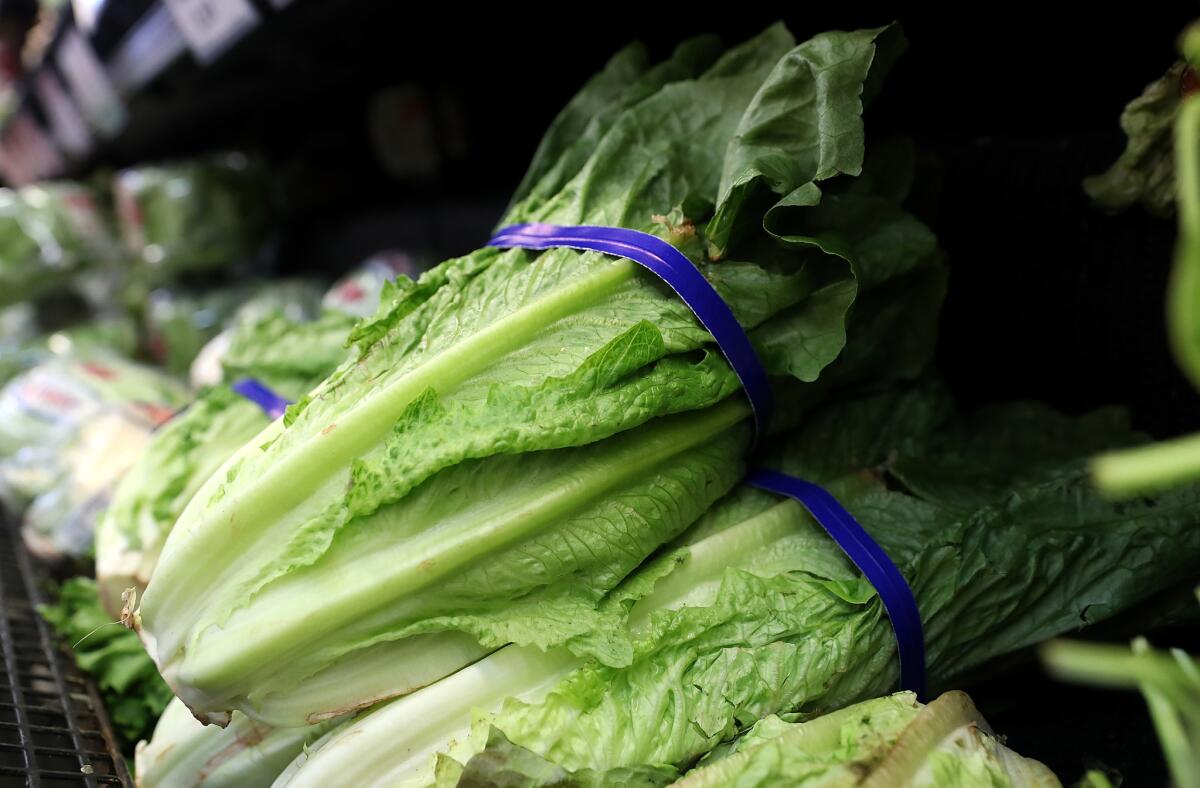Our food is tainted with E. coli, yet the FDA is rolling back safety rules

- Share via
Once again, the Centers for Disease Control and Prevention is warning us to steer clear of romaine lettuce contaminated with the deadly E. coli O157:H7. This time it’s lettuce grown in California’s Salinas Valley that has hospitalized 39 people in 19 states.
This marks the fourth outbreak of E. coli in romaine lettuce in the last two years. These outbreaks lay bare an alarming truth that contradicts a century of germ consciousness and progress in public health: Our food system still is not safe. And the Trump administration’s aversion to safety regulations means that this will not be the last outbreak.
News coverage of E. coli outbreaks tends to make lettuce contamination seem like a fluke in an otherwise functional system, often focusing on contamination of the outer surfaces of lettuce leaves, as if the bacteria were principally spread by occasional splashing from irrigation water or by drifting, airborne soil particles from nearby dairy farms.
But research on bacterial contamination of lettuce has come to a contrary and worrisome conclusion — bacteria-tainted water does not need to accidentally splash on lettuce leaves to contaminate them. In 2002, Ethan Solomon and his colleagues at Rutgers University showed that E. coli in irrigation water travels through the roots of lettuce plants and into the lettuce leaves. Even after the outer surface of the leaves is chemically disinfected, E. coli cells are still in the plant tissue. Solomon’s research has deep implications for today’s E. coli outbreaks: Tainted irrigation water means tainted greens.
Indeed, a Food and Drug Administration study of the E. coli outbreak in April 2018 implicated irrigation water. The E. coli that sickened consumers showed a DNA-sequence match only to bacteria from the irrigation canal that watered several miles of romaine. Putting this together with the Solomon study, it’s clear that the tainted water could have contaminated an entire field of lettuce.
FDA rules enacted during the Obama era would have required monitoring and treating irrigation water for E. coli, starting in 2018. Farms would monitor their irrigation water for pathogens at least once each growing season and possibly more frequently depending on proximity to potential pathogen sources. Following discovery of microbial pollution, the rules require mitigation of the danger, either by treating the water or by switching to an uncontaminated water source.
But President Trump’s first FDA commissioner, Scott Gottlieb, rolled back the regulations until 2022, saying that microbial quality standards for agricultural water are “too complicated, and in some cases too costly, to be effectively implemented.”
Leafy greens industry officials say that the industry standard is to monitor the water once a month. But the point of having federal rules is to ensure that all farms comply with water testing standards. The FDA rules would require more frequent testing if the likelihood of contamination from a known source, such as a nearby livestock farm with untreated feces, increases.
We should not be surprised that a regulation-averse administration would disregard the science of food safety, but it is concerning that consumers are complacent about yearly outbreaks of E. coli contamination and largely silent about the rollback of food safety regulations.
This wasn’t always the case. A century ago, when the concept of germs was still new to the American consciousness, Americans became obsessed with keeping themselves free of infections. Fixtures of today’s consumer landscape — white porcelain toilets, plastic-wrapped food and tiny bars of soap in hotels — are all relics of Americans’ earlier obsession with germs.
In the early 1900s, public health campaigns and consumer goods made the science of microbiology an everyday feature of daily life. Canned food producers emphasized the scientific sterility of their goods, and bread manufacturers found that “sanitary packaging” increased their profits. Science was good for business.
Beyond packaging, a new social ethic of disease prevention was born. Containing one’s own infections and the infections of others wasn’t just good hygiene, it was good citizenship, a marker of a highly collaborative public health ethic.
In the late 19th century, before germs were appreciated as responsible for our illnesses, street vendors would routinely spit on their handkerchiefs to polish their apples for sale. But when the science of germ theory became accepted, the general public came to view such behavior as disgusting and dangerous, and street vendors were forced to adapt.
Historical shifts in what the public accepts as healthful have brought vast improvements over the last century, from chlorinated drinking water to safe food-handling practices in restaurants.
Americans have never lost our visceral disgust for infection — think how nervous we get when someone nearby starts sneezing and coughing — but outbreaks from salad greens have failed to register, perhaps because these outbreaks are viewed as one-off events and not as broad failures to keep our food free of dangerous germs.
Stronger regulations for irrigation water would help prevent romaine from becoming the pariah of the agricultural industry and would keep consumers safe. If we do nothing to protect produce from systemic bacterial contamination, we can be sure that it will happen again soon.
Frederick M. Cohan is a microbial ecologist and professor of biology in the College of the Environment at Wesleyan University. Isaac Klimasmith is an undergraduate and Doris Duke conservation scholar at Wesleyan.
More to Read
A cure for the common opinion
Get thought-provoking perspectives with our weekly newsletter.
You may occasionally receive promotional content from the Los Angeles Times.









